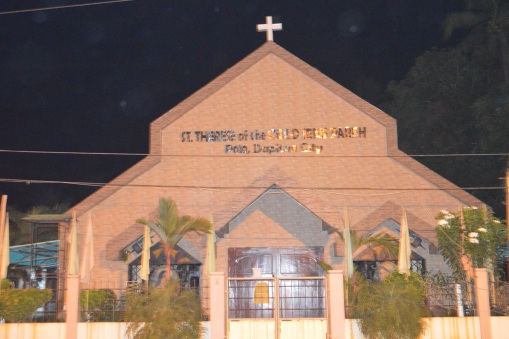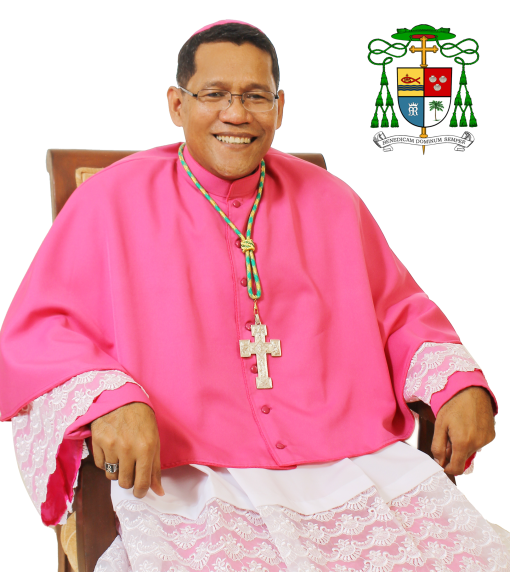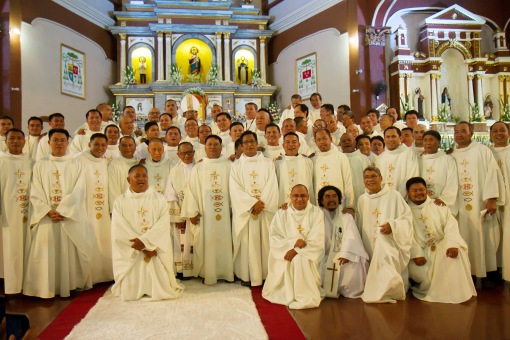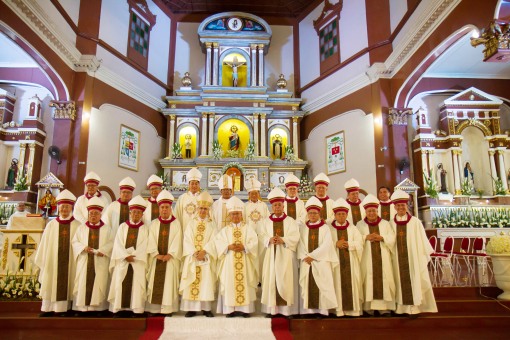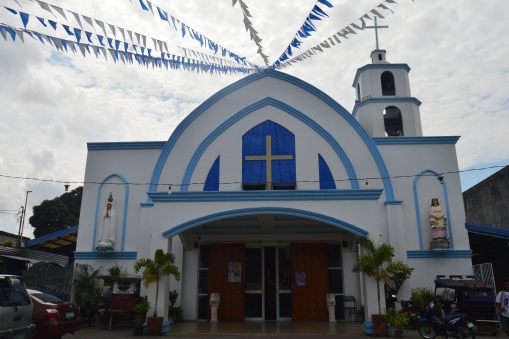
OUR LADY OF FATIMA PARISH
Sta. Filomena, Dipolog City
Parish Priest: Rev. Msgr. Joel S. Montederamos, V.G.
BRIEF HISTORY OF OUR LADY OF FATIMA PARISH
Founding of the Chapel. One moonless night sometime in 1933, the late Rafael Jabonillo who lives in Galas Gamay, a sitio of barrio Galas also known as Galas Dako, in his deep slumber dreamed about a wooden statue of Santa Filomena being kept in a wooden chest locally known as “kaban” of a certain friend in sitio Baybay. In his dream, Rafael Jabonillo, was said to have been requested by the blessed lady to build a chapel for her. Rafael woke up profusely perspiring, and pondered upon the revelatory significance in his dream.
Later in the morning, Rafael related to his brothers and a sister who resided nearby about his dream. Subsequently, he went to his friend in Baybay an adjacent sitio, and found the 12-inch wooden image of Santa Filomena placed in a wooden chest or “kaban”.
The story of Rafael’s dream and the good intention of the Jabonillo family to build a chapel for the blessed lady spread out in the neighborhood of over twenty families in sitio Galas Gamay. The small community, in a concerted effort, contributed generously their time and brought indigenous materials like nipa and bamboo to build the first chapel on the very lot where the present Santa Filomena church now stand. The original site was a portion of the share lot owned by the late Rafael Jabonillo who in his time executed the deed of donation thereof. Celebration for the feast of Santa Filomena was then held every August 10th where after the holy mass a banquet follow at almost every household.
In fact, during fiesta celebrations, according to oral history, selection for fiesta queen were held. There were also stage plays performed by homegrown talents dramatizing the life of Santa Filomena.
Rebuilding of the chapel. Lamentably, postwar years found the chapel ruined and dilapidated. Nevertheless, the residents who were professed Catholics rebuilt the chapel using this time lumber materials and G. I roofing – although the flooring was still the soil ground. When galas Mibang Association was organized in 1960 headed by Beder Morandarte, with the support of the PACD (Presidential Assistance on Community Development), the chapel was improved and expanded to accommodate the increasing population in the area. Earlier , the wooden icon of Sta. Filomena was replaced by a larger one due to the reason that the original wooden statue has become rotten and decayed. It was Nelia Opulentisima who donated the new statue.
Our Lady of Fatima in Barangay Sta. Filomena. In 1961, Galas Gamay aspired to become a barrio. Incidentally, at almost the same time, the Vatican withdraw recognition of Santa Filomena in the roster of saints, it was said. So the movers of sitio Galas Gamay striving for a barrio status recommended to then Mayor Virginio Lacaya that if ever approved, Galas Gamay be renamed Barrio Santa Filomena, in honor and in memory of their patroness who was then withdrawn in the roster of saints by the Vatican.
In 1962, owing to the turn of events, the patroness saint, Santa Filomena, was replaced by Rev. Fr. Nicasio Patangan with the Our Lady of Fatima as the patroness of the newly created barangay Santa Filomena, with August 13 as its feast day.
It may be well to note that in February 14, 1961, the Sacred Congregation of the Rites decreed that the feast of Sta. Filomena is to be taken off from the Liturgical calendar which created an air of apprehension among believers. In 1964 when Supreme Pontiff Paul VI was in India, he was asked by the bishop of Misore, “what was required concerning the decree of February 14, 1961….?” the pope answered, “Continue as before and do not upset your people.” At a later time, devotees of Sta. Filomena resumed their feast day celebration every August 10th until the present time.
Chapel Leadership. In the beginning chapel leadership was voluntary and in accordance with ones decision. It was Rafael Jabonillo who first headed the chapel until his demise in a later year. He was succeeded by his brother, Alejandro; then followed by Andres Lopez, Conception Canturias, Andres Dacua, Pablo Canturias, Fortunato Carpitanos, and Sabino Reluya.
When the Sta. Filomena Catholic Chapel Association was organized, leadership of the chapel was then chosen thru election, Pablo Canturias was first elected as chapel president; then followed by Zoilo Sy. It was during the incumbency of chapel president Zoilo Sy that the chapel of Santa Filomena was concreted and expanded to become quite imposing and turn into a most sought – after chapel of Dipolog parish as venue for wedding ceremonies. Thanks to the cooperative efforts of the local parishioners and to Roberto Uy (who later became City Mayor of Dipolog), his brother Godofredo “Pedoy” Uy, Mrs. Arsenia Uy, and Ms. Lilian Young who generously helped in expansion and beautification of the Santa Filomena chapel being relentlessly pursued by Zoilo Sy, who in fact, acquired additional parcel adjacent to the original lot providing the chapel area with much larger premises. The newly acquired lot was then owned by Ignacio Jabonillo.
The spouses Wilson Cardenas and Perla Cardenas took turn in managing the chapel as president, respectively, when the Sta. Filomena Chapel Pastoral Council was organized in place of the Sta. Filomena Catholic Chapel Association. This was followed by Raul Sy, then by Guillermo Dequito. Raul Sy was re – elected as chapel president in 2009 that Raul Sy launched a signature campaign indorsing a petition along with some – requirements relative thereof, to Most Reverend Jose R. Manguiran, bishop of Dipolog Diocese, seeking to make Santa Filomena as quasi – parish. Quasi parish is the step to become a parish.
Sta. Filomena canonically erected as a Quasi – Parish. More than a year after the petition was submitted, more particularly during the fiesta celebration on August 13, 2011, in the concelebrated mass, Bishop Jose Manguiran canonically erected Santa Filomena as a Quasi Parish comprising the chapels of San Roque in Sta. Isabel ; Medalla Milagrosa in Mibang and the entire territorial civil jurisdiction of barangay Sta. Filomena. Rev. Fr. Cesar D. Tinga, Cor Jesu Seminary rector, was designated as Quasi Parish administrator. Another chapel was however erected in 2015. The Our Mother of Perpetual Help Church at Ramos Village.
CPC replaced with PPC/PCL. In December 2011, election was held for the members of the first regular Parish Pastoral Council (PPC), replacing the Chapel Pastoral Council. Damon Alo, was elected vice president while the parish priest is automatic chairman of the PPC in accordance with the diocesan policy. In conformity with the policy, the elected vice president will act as chairman of the Parish Council of the Laity. Brod. Damon Alo was re – elected as PCL Chairman in 2013 and served his second term up to 2015. He was succeeded by Michael Garces, who was elected as PCL chairman and served as such until December of this year, 2017.
Observance of Fiesta Celebration modified. Later development was made when Rev. Fr. Cesar D. Tinga, parish priest, proposed to amend the fiesta celebration from August 13 to May 13 taking into consideration that the apparitions of the Blessed Virgin Mary first appeared in Cova da Iria in Fatima, Portugal on May 13, 1917. The apparition is said to have appeared six times up to October 13 but never on August 13. The Our Lady of the Rosary reappeared to the three children on August 19 in Valenos, a village near Fatima, due to the kidnapping incident that happened to them and interrogating as to the secrets of the Fatima which they refused to reveal as it was not the time yet. Also considered is the fact that the feast celebration of Santa Filomena is continuously observed by its devotees making two fiesta celebrations within a matter of days. Moreover, the month of May is vacation time and students who are schooling locally or elsewhere could have the luxury of time to attend fiesta activities.
In deference therefore to the devotees of Santa Filomena, who are mostly old – timers in the parish, its August 10 celebration is still being continued to be celebrated and is dedicated as a Basic Ecclesial Community day or BEC Day.
Canonical erection as Parish. Finally, Santa Filomena was conically erected as a full – fledged Parish on May 13, 2012 by Most Rev. Jose R. Manguiran, D.D., bishop of Dipolog Diocese, with Rev. Fr. Cesar D. Tinga appointed as its first parish priest. The Our Lady of Fatima is the primary patroness saint while Santa Filomena is the secondary patroness of the new parish. With his appointment, Fr. Tinga immediately started one of his missions to build a bigger building structure to be called Parish Church of Santa Filomena with its patroness Saint the Our Lady of Fatima. With his untiring efforts, and with the help of the parishioners, benefactors, donors and sponsors, and by the grace of God, in a span of 5 years, an imposing building, costing about 12M proudly stood in its grandeur as the Sta. Filomena Parish Church, fully air-conditioned and installed with CCTV cameras. The Parish Church was consecrated to its patroness Saint the Our Lady of Fatima on December 8, 2015.
In running the operations and affairs of the Parish Office, Rev. Fr. Tinga is presently assisted by the Parish Management Staff (PMS) composed of Finance Officer Nelly O. Bogo, Parish Secretary Jojo Taleon, Cashier Nelly Bagarinao, and Clerks Merlita Bulabon and Venna Castillon-Ligutom.
Past and Present parish priest, administrator and parochial vicars.
= Rev. Fr. Cesar D. Tinga
=Rev. Msgr. Joel S. Montederamos, V.G.-May 30, 2019 – present
